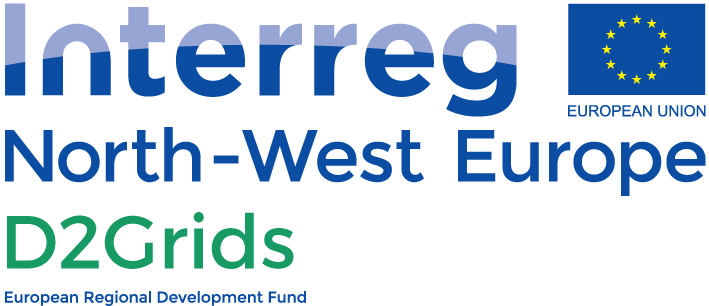Call for Capitalisation
The European D2GRIDS project, which aims to develop 5th Generation Local Energy Grids has been extended in order to strengthen synergies between electrical uses and heating & cooling grids in order to better decarbonise our cities and territories.
Rolling-out 5th generation district heating and cooling systems (5GDHC) across North-West Europe
Developed in 2019 by 12 European partners, the D2Grids consortium also works on better integration of electrical uses and local renewable electricity production capacities, to improve the decarbonisation of 5GDHC networks.
D2Grids consortium has announced the extension of the Interreg North-West Europe (NWE) project, which started in 2019 and was developed by 12 European partners. The project aims to roll-out 5th generation district heating and cooling systems (5GDHC) across North-West Europe, thereby increasing the share of renewable energy and decreasing carbon emissions. D2Grids project aims to develop a generic technology model for 5th generation district heating and cooling networks, to create a solid business plan, to promote this new generation of smart local energy grids, train professionals for its deployment, and demonstrate the technology through impactful pilot investments in: Paris-Saclay (FR), Bochum (DE), Brunssum (NL), Glasgow (SC) and Nottingham (EN).
The extension of the D2Grids project is a result of Interreg NWE 2nd call for capitalisation. Through this call, the project has received an additional 2.5 million EUR of funding to maximise its impact through new activities and extended cooperation. This 23.7 million EUR project is supported by Interreg North-West Europe funds, covering close to 60% of the fundings (14.1 million EUR).
Strengthening the synergies between DHC and electricity networks in cities
As a result of the 2nd capitalisation call, in addition to the main project work on the heating and cooling dimensions of these closed energy grids, the D2Grids consortium has also worked on better integration of electrical uses and local renewable electricity production capacities, to improve the decarbonisation of 5GDHC networks. GreenFlex was the leader of this new “Capitalisation Work Package”, which is composed of 7 partners from the initial consortium (Mijnwater B.V, Asper Investment Management, Clyde Gateway, Open University, Construction21, VITO and GreenFlex) and 4 partners (Engie Services Netherlands, Scottish Water Horizons, LLC & Associates Lawyers and the French Social Housing Company Seqens).
The consortium has worked on combining best practices in 5GDHC networks with best practices in local renewable electricity generation, distribution, storage and management. It has allowed the creation of more decarbonised multi-carrier local energy communities, delivering high quality service and a competitive business model for local producers and consumers. In utilizing multienergy dynamics, it has enabled us to integrate the lessons learned from the addition of collective self-consumption photovoltaic to 5GDHC projects in the different countries concerned.
The consortium works to demonstrate the technical, legal, economic and organisational relevance of integrating local renewable electricity and heat production with local needs for heating, cooling, and electricity (from buildings, urban structures or even charging stations for electric vehicles) and considering the associated possibilities for better flexibility (reducing peak demand or utilising storage).
Beyond its technical dimension, the project studied the contracting models for sharing locally produced energy as well as the associated economic models (financial models, revenue from energy sales, etc.) in order to disseminate the lessons learned. Three of the D2Grids pilot sites in Glasgow (UK), Brunssum (Netherlands) and Paris-Saclay (France), have been testing the synergies between electricity networks and heating and cooling grids. One of the challenges were to turn these into models of best practice, to encourage future project developers to consider integrated 5GDHC networks as a solution for their energy transition needs. This encourages, in line with the goals of the D2Grids project, an increase in the share of renewable energies and decarbonisation in cities and territories in Northwest Europe.
And what about D2Grids now ?
The 5th generation district heat and cold grid (5GDHC) was first developed in Heerlen, Netherlands, by Mijnwater Energy Ltd. In contrast to traditional district heating, it is an intelligent thermal network based on a local lowtemperature loop. Decentralised energy production, using heat pumps located at the user’s premises, allows energy exchange on the network, where flows are demand-driven.
This concept allows the recovery of cold and heat emitted by supermarkets, data centers, factories, offices etc. D2GRIDS stands for « demand-driven grids ». It is an Interreg Northwest Europe (NWE) project that runs for more than 5 years (2018-2023). Mijnwater Energy Ltd, based in the Netherlands, is coordinating the project with 15 other main partners and 6 secondary partners. Five pilot sites located in Paris-Saclay (France), Bochum (Germany), Brunssum (Netherlands), Glasgow and Plymouth (UK) have developed 5GDHC networks.
Extract from this article : https://mijnwater.com/en/d2grids-interreg-nwe
